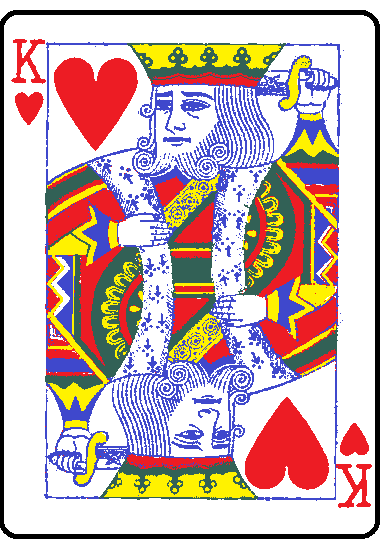

Trump [トランプ, toranpu] is the Japanese word for the standard 52-card Western playing card deck.
The deck contains numbers and courts from Ace, 2 to 10, Jack, Queen, and King. The four suits are of the french pattern: Clubs, Spades, Hearts, and Diamonds. Most decks include Joker(s) (or Best Bower(s)) in addition to the 52 cards.
The term ‘trump’ first appeared in Japanese in an 1885 book titled Seiyō Yūgi Karuta Shiyō-hō (Usage of Western Playing Karuta). The english term originally refered to the strongest card in trick-taking games, and it is not clear how it came to be used to refer to the playing card deck in general.
Contrary to popular belief, these were not the type of cards that were introduced by the Portuguese when they first traveled to Japan. Neither were they the kind of cards that eventually evolved into Hanafuda. In fact, they didn’t even become widely played in Japan until after the end of the Edo period in 1868, during which the opening of trade to Western forces caused these types of cards to be imported to Japan from United States and England.
For Japanese games played using these cards, click here.
¶ History of 52-card French-suited decks in Japan
¶ Oranda Karuta (‘Dutch playing cards’)
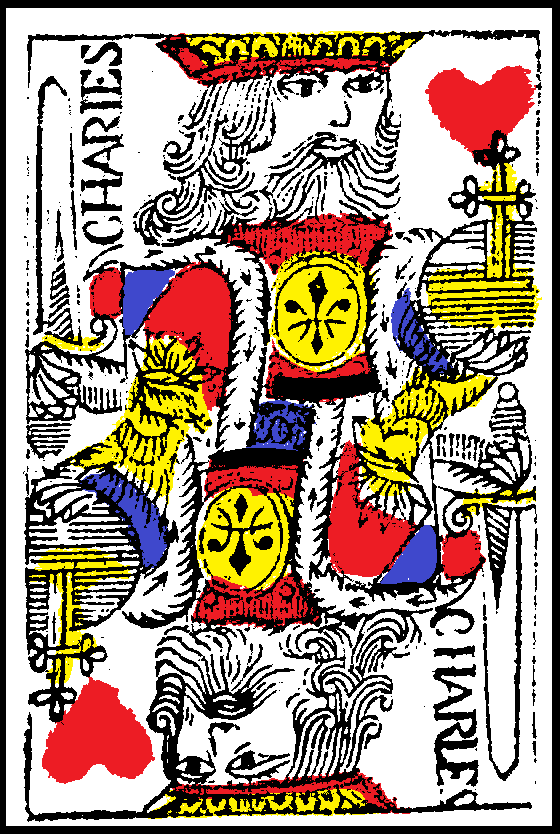
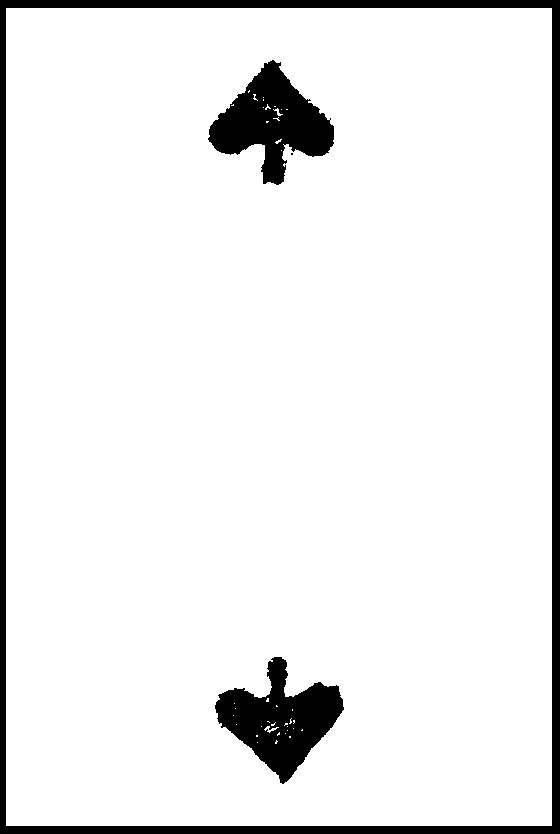
Even before the Meiji era (1868-1912), some French-suited 52-card decks have made their way through Japanese shores. These decks were made in the Netherlands, and were brought to Japan by the Dutch since they have established formal trading relations with Japan in 1609.
There were many accounts of these decks being brought to Japan and being played there, but very few physical relics exist today.
It is thought that the game E-tori was originally played using these decks.
¶ Udagawa Yōan’s copy of Oranda Karuta (和蘭闘牌)
When Jan Cock Blomhoff, the director of a Dutch trading colony in Nagasaki called Dejima, arrived to Japan for the second time in August 1817, accompanied with his wife and son among other people, he brought with him twelve types of toys, one of which was a deck of playing cards.
Udagawa Yōan, a Japanese scholar of Western studies who had a close relationship with Blomhoff, knew of these “twelve rare toys” and copied some of them. The “Dutch cards” in particular were copied in his room on April 10, 1821. The copy survived a fire in 1834 and was handed down to the descendants of the Udagawa family. A replica of this deck, which was reprinted at Nintendo by the Rangaku Materials Study Group, can be found at the Tsuyama Archives of Western Learning.
While the copy of the deck exists today , the original Dutch-made cards were nowhere to be seen, probably because they remained in Blomhoff’s possession when they were deported away from Japan.
¶ Hayashi Shihei’s Oranda Karuta (阿蘭陀加留多)
Remains of a Dutch-made playing card deck (Two cards: A Jack of hearts and a 9 of spades, both bearing designs resembling those made during the late 18th century) became an exhibited item at the Hayashi Shihei Memorial Exhibition at the Sendai City Museum.
It is said that Hayashi Shihei, a Japanese military scholar and a retainer of the Sendai Domain, has taken advantage of his position to visit Nagasaki three times since 1775. From there, he bought the Dutch card deck, along with a deck of Chinese money-suited paper cards, and gave them as a gift to his friend Fujitsuka Shikibu, who was a Shinto priest at Shiogama Shrine.
Currently this is the only physical evidence of Dutch playing cards coming to Japan before the Meiji period that exists today.
¶ Introduction of Cards from United States and England
The opening of Japan to trade with Western forces in the Mid-1850’s, leading to the Meiji Restoration in 1868 made the import of western playing cards to Japan possible.
The visitation of an executive of British card manufacturer Goodall to promote sales, the subsequent request from the British side to lift the ban on playing card imports, the subsequent decision to officially approve imports, and the large-scale public sales of karuta by Kamigata-ya in Ginza, Tokyo, were the catalysts for the mass introduction of these cards to Japan during the 1880’s.
The cards were called by several names which did not stick. At first it was called by the strange name Seiyō karuta (“western karuta”), then Toronpu (“trompe”) or Toranpu (“trump”) and Pāsu or Pā (“pas”). However, in the 1890’s, Kamigata-ya, a highly influential shop that openly sold karuta to the public, used the name Toranpu in an instructional book distributed to promote the sale of karuta. The term became commonly used and it stuck, and to this day, western playing cards are always called Toranpu in Japan.
¶ Local Manufacture of Trump in Japan
In 1902, Yamauchi Nintendo (now Nintendo Co., Ltd.) started sales of western playing cards that were domestically produced in Japan. It is thought that Toyo Printing, which is owned by Cigarette manufacturer Murai Bros. & Co., bought second-hand playing card printing machines from Perfection Playing Card Co. and produced the playing cards for Yamauchi Nintendo. However, a different printing company named Watada Printing Co. Ltd. mentions in their company history that in 1902, they produced western playing cards for “Nintendo Koppai” using copperplate printing technology.
There was a story that the first Japanese-made western playing cards were sold by Nintendo in an effort to comfort the Russian POW’s during the Russo-Japanese War of 1904-1905. However, Takashi Ebashi stated that he had seen playing cards made by Yamauchi Nintendo in the USPCC Museum (which closed sometime before the transfer of USPCC’s factory from Cincinnati, Ohio to Erlanger, Kentucky in 2009), which were collected by USPCC in 1903- a year before the Russo-Japanese War even started.
¶ Hana-Trump
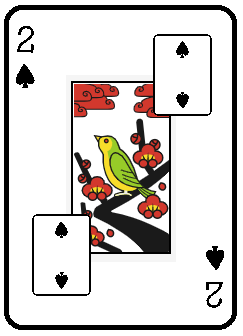
In the 20th century, the designs of both Western playing cards and Hanafuda merged to form Hanafuda-Trump (花札トランプ), also known as Hana-Trump or Hanatora (花トラ).
Hana-Trump is a western playing card deck containing 52 cards (plus joker(s)). Hanafuda card patterns adorn the middle part of each card, while corner indices indicate the number and suit of the card.
However, since a hanafuda deck only contains 48 cards, it is up to the manufacturer how they would decorate the four Kings in the deck. Some manufacturers put their manufacturer’s mark or advertisements of their products. Others put drawings of Hachi-hachi tools on them, and are intended to be used just like their actual counterparts. Still others leave the designs of their corresponding Kings untouched from their western playing card counterparts.
¶ Murai Bros. Tobacco Cards - Hana-Trump sets
Some sets of collectible tobacco cards from packs of Murai Bros. Cigarettes contain designs of hanafuda, with a western playing card drawn on one of the corners of each card.
Karuta manufacturer Tsuchida Tenguya took one of such sets and created an actual hanafuda deck (complete with backpasting) using the design of that set.
¶ Richert Karuta’s “Shiki” - A western deck disguised as Hanafuda
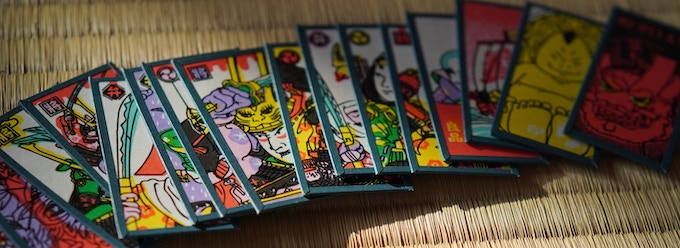
In 2022, Marcus Richert announced a new type of deck called “Shiki” on Kickstarter.
This deck was described as a western playing card deck in disguise as a hanafuda deck.
The construction of each card is that of Japanese karuta- made of thick cards wrapped together with a backpaper. However, the structure of the deck is identical to a 52-card western deck:
- The cards have four suits represented by four types of flowers.
- Each suit has 10 numbers and 3 court cards.
- Jokers are also included.
In addition to the various Japanese-inspired illustrations, the iconography of brights, animals, and ribbons of hanafuda are incorporated into the deck, which makes it possible to use the deck as a hanafuda deck if you know the month sequence.
The deck originally came in two editions of two patterns each. The standard edition has a plain, one-colored back, and is made in-house at Richert Karuta in northern Osaka. The limited edition has an elaborate “sayagata” pattern on the back, and has the faces of seven “bright” cards stamped with silver ink. This edition is made at Oishi Tengudo. An additional third edition was made- the standard edition silver- which is the standard edition with the plain backs but the seven bright cards are stamped with silver ink. All editions are traditionally hand-made.
The two patterns- Poets and Warriors- differ slightly in each other except for the pip cards. The Poets pattern have courts represented by Heian-period poets, while the Warriors pattern have Heian-period warriors instead.
¶ Bibliography
- https://ja.wikipedia.org/wiki/トランプ
- https://japanplayingcardmuseum.com/1-1-3-1-dutchcards-udagawa-youan/
- https://japanplayingcardmuseum.com/1-1-3-2-dutchcards-hayashi-shihei/
- https://twitter.com/gelcyz/status/1401543909868642305
- https://www.city.sendai.jp/museum/kidscorner/kids-08/kidscorner-06/kids-38.html
- https://en.wikipedia.org/wiki/Hayashi_Shihei
- https://japanplayingcardmuseum.com/1-1-5-1-american-british-earlymeijiera/
- https://history.state.gov/milestones/1830-1860/opening-to-japan#:~:text=On July 8%2C 1853%2C American,Japan and the western world.
- https://japanplayingcardmuseum.com/114-1-2-westerncard-domesticproducts-exportation/
- https://www.watada.co.jp/company/outline/
- https://www.playingcardmakerscollection.co.uk/Cardhtml/W0329.html
- https://www.kickstarter.com/projects/karuta/shiki-japanese-style-playing-cards/description